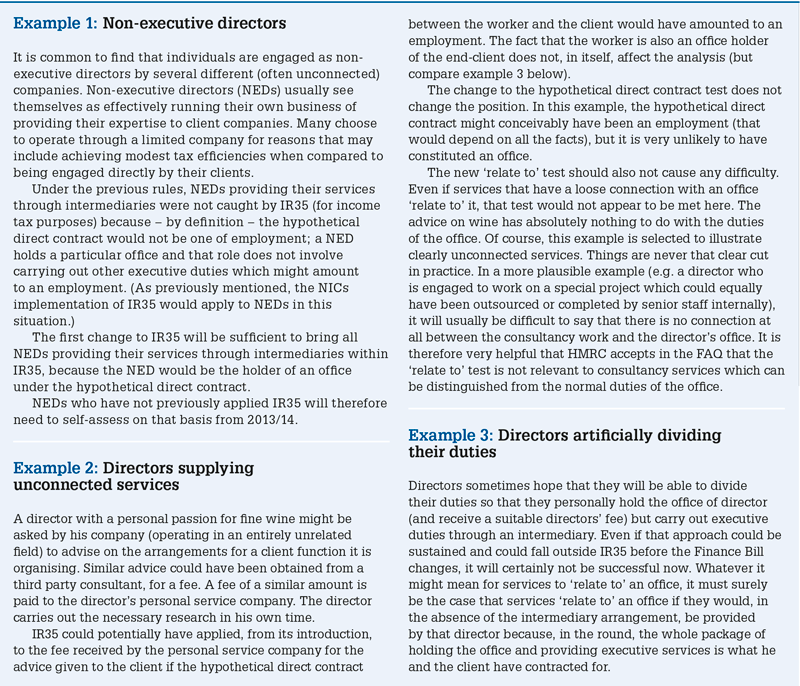There are two changes to IR35 in the Finance Bill affecting office holders (and particularly non-executive directors). Firstly, IR35 will now apply where a hypothetical direct contract between the worker and client would amount to the holding of an office, as well as where that contract would have been one of employment. Secondly, an alternative test is added where officers of a company supply services to it through an intermediary arrangement: IR35 will apply where the services ‘relate to’ that office (though the meaning of ‘relate to’ is not entirely clear).
Recent changes affect office holders and non-executive directors, in particular, warns Dan Pipe.
 For the whole of their troubled life so far, the intermediaries rules for income tax (ITEPA 2003 Part 2 Chapter 8 and commonly called ‘IR35’) have only applied where the contract that would exist in the absence of an intermediary arrangement would have been a contract of employment between the worker and the end client. The Finance Bill amends IR35 so that in some circumstances the ‘hypothetical direct contract’ need not be tested.
For the whole of their troubled life so far, the intermediaries rules for income tax (ITEPA 2003 Part 2 Chapter 8 and commonly called ‘IR35’) have only applied where the contract that would exist in the absence of an intermediary arrangement would have been a contract of employment between the worker and the end client. The Finance Bill amends IR35 so that in some circumstances the ‘hypothetical direct contract’ need not be tested.
The origin of the change is last year’s consultation into the taxation of controlling persons, prompted by several high profile public sector examples of senior executives providing their services through an intermediary. The summary of responses to that consultation rejected the idea of a revived ‘controlling person’ test, and concluded that what was primarily needed was better enforcement of IR35. Other practical measures introduced in the public sector have been discussed elsewhere.
The Finance Bill introduces a small amendment (taking only 11 lines) intended to bring officeholders within IR35 for income tax purposes from 6 April (Finance Bill cl 22 – see the box ‘The amended legislation’). In the private sector, ‘office holder’ in the context of IR35 will almost always be synonymous with ‘director’.

Clearly, this is an amendment of two halves:
The first change aligns the income tax position with the NICs position (SSCBA 1992 s 4A and SI 2000/727), which never required the hypothetical contract to be one of employment, only that it be one under which the worker would have been regarded as ‘employed in employed earner’s employment’; this includes being an office holder (SSCBA 1992 s 2(1)(a)). It also ensures that IR35 cannot be avoided by appointing an intermediary company as the office holder of the client company.
Example 1 shows the implications of the first change for non-executive directors.
The second change is more difficult to unpick. Workers holding an office with the client will be subject to IR35 if the services they provide through an intermediary arrangement ‘relate to’ that office. The draft clause offers no guidance on what ‘relate to’ might mean in this context. The explanatory notes do not offer any practical assistance. The precise meaning of ‘relate to’ is important because, under this new IR35 test, there is no need to consider the nature of the hypothetical direct contract: if services being provided by a worker (who is also an officer of the client) ‘relate to’ the office, IR35 will apply without any further enquiry.
A cautious interpretation of ‘relate to’ might fairly assume that a loose connection between the services being provided and the worker holding the office would be sufficient to engage IR35. However, additional FAQs recently published by HMRC suggest that that interpretation might not be warranted (see the third FAQ at www.hmrc.gov.uk/ir35/director.htm). HMRC gives the example of a non-executive director providing consultancy services, and confirms that those consultancy services should be subject to the usual ‘hypothetical direct contract’ test. If that is right, it must be the case that services only ‘relate to’ the office if they are services provided as a natural consequence of holding that office (which have been artificially separated and provided through an intermediary).
Examples 2 and 3 below explore the effect of the new test.

If services that ‘relate to’ an office are actually services that are provided as the natural consequence of holding that office, it is unfortunate that clearer language was not chosen. For example, the new test could have considered whether it would be reasonable to assume that, if the services had not been provided through an arrangement with an intermediary, they would have been provided under, or pursuant to, the office the worker held with the client. This sort of formulation could neatly have caught artificially divided duties but left the position clearer for directors supplying other services to client companies. In most cases, directors could easily apply this type of test to themselves – they will know whether they would have provided the services in their capacity as directors if their intermediary had not been engaged to do so.
In the absence of clearer legislation, it is fortunate that HMRC’s FAQs take a sensible approach to directors providing separate consultancy services along the lines of example 2.
Advisers will want to:
There are two changes to IR35 in the Finance Bill affecting office holders (and particularly non-executive directors). Firstly, IR35 will now apply where a hypothetical direct contract between the worker and client would amount to the holding of an office, as well as where that contract would have been one of employment. Secondly, an alternative test is added where officers of a company supply services to it through an intermediary arrangement: IR35 will apply where the services ‘relate to’ that office (though the meaning of ‘relate to’ is not entirely clear).
Recent changes affect office holders and non-executive directors, in particular, warns Dan Pipe.
 For the whole of their troubled life so far, the intermediaries rules for income tax (ITEPA 2003 Part 2 Chapter 8 and commonly called ‘IR35’) have only applied where the contract that would exist in the absence of an intermediary arrangement would have been a contract of employment between the worker and the end client. The Finance Bill amends IR35 so that in some circumstances the ‘hypothetical direct contract’ need not be tested.
For the whole of their troubled life so far, the intermediaries rules for income tax (ITEPA 2003 Part 2 Chapter 8 and commonly called ‘IR35’) have only applied where the contract that would exist in the absence of an intermediary arrangement would have been a contract of employment between the worker and the end client. The Finance Bill amends IR35 so that in some circumstances the ‘hypothetical direct contract’ need not be tested.
The origin of the change is last year’s consultation into the taxation of controlling persons, prompted by several high profile public sector examples of senior executives providing their services through an intermediary. The summary of responses to that consultation rejected the idea of a revived ‘controlling person’ test, and concluded that what was primarily needed was better enforcement of IR35. Other practical measures introduced in the public sector have been discussed elsewhere.
The Finance Bill introduces a small amendment (taking only 11 lines) intended to bring officeholders within IR35 for income tax purposes from 6 April (Finance Bill cl 22 – see the box ‘The amended legislation’). In the private sector, ‘office holder’ in the context of IR35 will almost always be synonymous with ‘director’.

Clearly, this is an amendment of two halves:
The first change aligns the income tax position with the NICs position (SSCBA 1992 s 4A and SI 2000/727), which never required the hypothetical contract to be one of employment, only that it be one under which the worker would have been regarded as ‘employed in employed earner’s employment’; this includes being an office holder (SSCBA 1992 s 2(1)(a)). It also ensures that IR35 cannot be avoided by appointing an intermediary company as the office holder of the client company.
Example 1 shows the implications of the first change for non-executive directors.
The second change is more difficult to unpick. Workers holding an office with the client will be subject to IR35 if the services they provide through an intermediary arrangement ‘relate to’ that office. The draft clause offers no guidance on what ‘relate to’ might mean in this context. The explanatory notes do not offer any practical assistance. The precise meaning of ‘relate to’ is important because, under this new IR35 test, there is no need to consider the nature of the hypothetical direct contract: if services being provided by a worker (who is also an officer of the client) ‘relate to’ the office, IR35 will apply without any further enquiry.
A cautious interpretation of ‘relate to’ might fairly assume that a loose connection between the services being provided and the worker holding the office would be sufficient to engage IR35. However, additional FAQs recently published by HMRC suggest that that interpretation might not be warranted (see the third FAQ at www.hmrc.gov.uk/ir35/director.htm). HMRC gives the example of a non-executive director providing consultancy services, and confirms that those consultancy services should be subject to the usual ‘hypothetical direct contract’ test. If that is right, it must be the case that services only ‘relate to’ the office if they are services provided as a natural consequence of holding that office (which have been artificially separated and provided through an intermediary).
Examples 2 and 3 below explore the effect of the new test.

If services that ‘relate to’ an office are actually services that are provided as the natural consequence of holding that office, it is unfortunate that clearer language was not chosen. For example, the new test could have considered whether it would be reasonable to assume that, if the services had not been provided through an arrangement with an intermediary, they would have been provided under, or pursuant to, the office the worker held with the client. This sort of formulation could neatly have caught artificially divided duties but left the position clearer for directors supplying other services to client companies. In most cases, directors could easily apply this type of test to themselves – they will know whether they would have provided the services in their capacity as directors if their intermediary had not been engaged to do so.
In the absence of clearer legislation, it is fortunate that HMRC’s FAQs take a sensible approach to directors providing separate consultancy services along the lines of example 2.
Advisers will want to:







